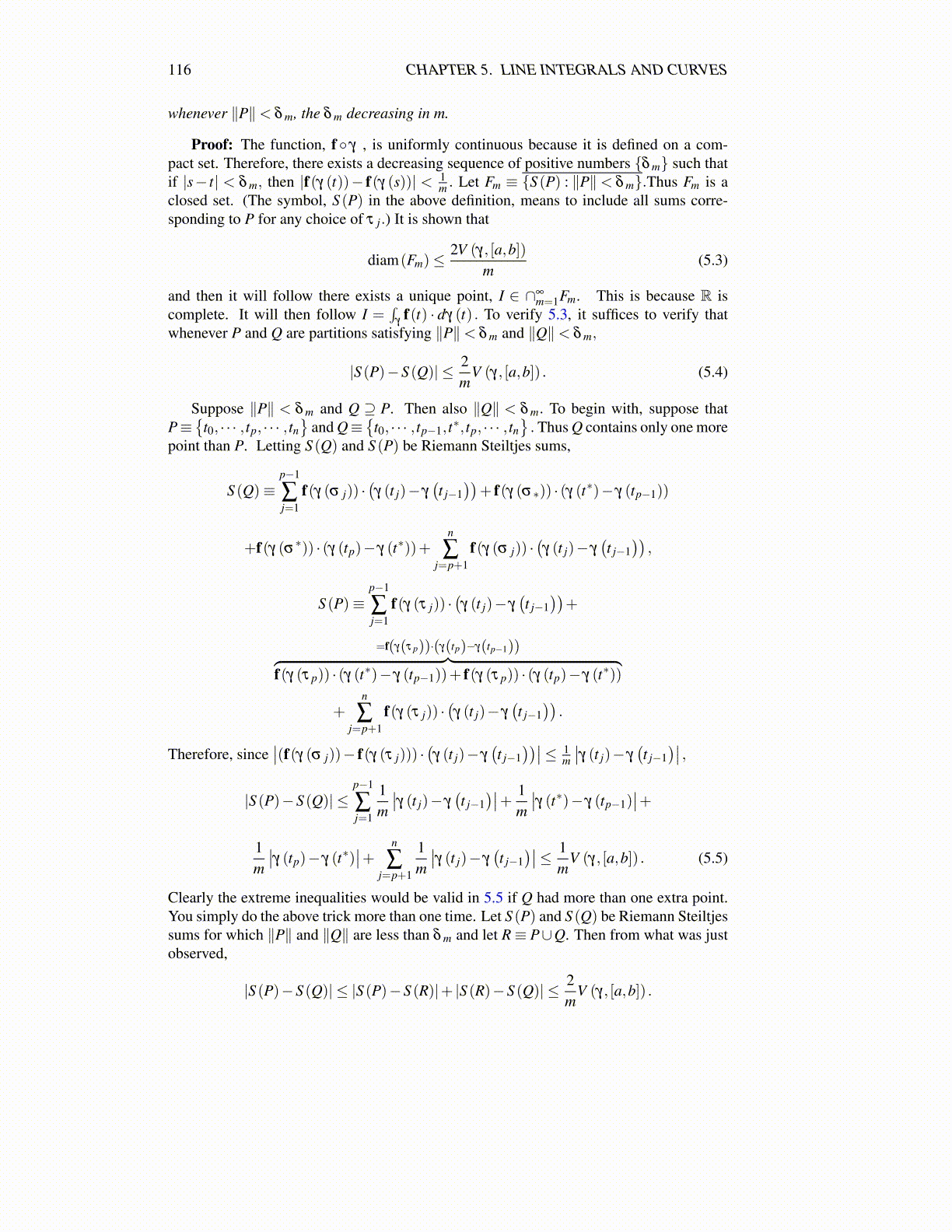
116 CHAPTER 5. LINE INTEGRALS AND CURVES
whenever ∥P∥< δ m, the δ m decreasing in m.
Proof: The function, f ◦ γ , is uniformly continuous because it is defined on a com-pact set. Therefore, there exists a decreasing sequence of positive numbers {δ m} such thatif |s− t| < δ m, then |f(γ (t))− f(γ (s))| < 1
m . Let Fm ≡ {S (P) : ∥P∥< δ m}.Thus Fm is aclosed set. (The symbol, S (P) in the above definition, means to include all sums corre-sponding to P for any choice of τ j.) It is shown that
diam(Fm)≤2V (γ, [a,b])
m(5.3)
and then it will follow there exists a unique point, I ∈ ∩∞m=1Fm. This is because R is
complete. It will then follow I =∫
γf(t) · dγ (t) . To verify 5.3, it suffices to verify that
whenever P and Q are partitions satisfying ∥P∥< δ m and ∥Q∥< δ m,
|S (P)−S (Q)| ≤ 2m
V (γ, [a,b]) . (5.4)
Suppose ∥P∥ < δ m and Q ⊇ P. Then also ∥Q∥ < δ m. To begin with, suppose thatP≡
{t0, · · · , tp, · · · , tn
}and Q≡
{t0, · · · , tp−1, t∗, tp, · · · , tn
}. Thus Q contains only one more
point than P. Letting S (Q) and S (P) be Riemann Steiltjes sums,
S (Q)≡p−1
∑j=1
f(γ (σ j)) ·(γ (t j)− γ
(t j−1
))+ f(γ (σ∗)) · (γ (t∗)− γ (tp−1))
+f(γ (σ∗)) · (γ (tp)− γ (t∗))+n
∑j=p+1
f(γ (σ j)) ·(γ (t j)− γ
(t j−1
)),
S (P)≡p−1
∑j=1
f(γ (τ j)) ·(γ (t j)− γ
(t j−1
))+
=f(γ(τ p))·(γ(tp)−γ(tp−1))︷ ︸︸ ︷f(γ (τ p)) · (γ (t∗)− γ (tp−1))+ f(γ (τ p)) · (γ (tp)− γ (t∗))
+n
∑j=p+1
f(γ (τ j)) ·(γ (t j)− γ
(t j−1
)).
Therefore, since∣∣(f(γ (σ j))− f(γ (τ j))) ·
(γ (t j)− γ
(t j−1
))∣∣≤ 1m
∣∣γ (t j)− γ(t j−1
)∣∣ ,|S (P)−S (Q)| ≤
p−1
∑j=1
1m
∣∣γ (t j)− γ(t j−1
)∣∣+ 1m
∣∣γ (t∗)− γ (tp−1)∣∣+
1m
∣∣γ (tp)− γ (t∗)∣∣+ n
∑j=p+1
1m
∣∣γ (t j)− γ(t j−1
)∣∣≤ 1m
V (γ, [a,b]) . (5.5)
Clearly the extreme inequalities would be valid in 5.5 if Q had more than one extra point.You simply do the above trick more than one time. Let S (P) and S (Q) be Riemann Steiltjessums for which ∥P∥ and ∥Q∥ are less than δ m and let R≡ P∪Q. Then from what was justobserved,
|S (P)−S (Q)| ≤ |S (P)−S (R)|+ |S (R)−S (Q)| ≤ 2m
V (γ, [a,b]) .